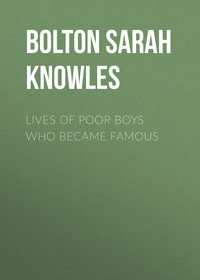 полная версия
полная версияFamous Givers and Their Gifts
In 1721, when Mr. Guy was seventy-six years of age, he leased a large piece of ground of St. Thomas's Hospital for a thousand years at £30 a year, to erect upon it a great hospital for incurables; "to receive and entertain therein four hundred poor persons, or upwards, laboring under any distempers, infirmities, or disorders, thought capable of relief by physic or surgery; but who, by reason of the small hopes there may be of their cure, or the length of time which for that purpose may be required or thought necessary, are or may be adjudged or called incurable, and as such not proper subjects to be received into or continued in the present hospital, in and by which no provision has been made for distempers deemed or called incurable."
While Mr. Guy had primarily in mind the poor and incurable, and the insane as well, in his will he directed the trustees to use their judgment about the length of time patients should remain, either for life or for a short period. Mr. Guy at once procured a plan for his hospital, and in the spring of 1722 laid the foundations. He went to the work "with all the expedition of a youth of fortune erecting a house for his own residence." The original central building of stone cost £18,793. The eastern wing, begun in 1738, was completed at a cost of £9,300; the western wing, in 1780, at a cost of £14,537.
Mr. Guy lived to see his treasured gift roofed in before his death, which occurred Dec. 27, 1724, in his eightieth year. In a little more than a week afterwards, Jan. 6, 1725, his hospital was opened, and sixty patients were admitted.
After the death of Mr. Guy one thousand guineas were found in his iron chest; and as it was imagined that these were placed there to defray his funeral expenses, they were used for that purpose. His body lay in state at Mercer's Hall, Cheapside, and was taken with "great funeral pomp" to the Parish Church of St. Thomas, Southwark, to rest there till the chapel at the hospital should be completed. Two hundred blue-coat boys from Christ's Hospital walked in the procession, and sang before the hearse, which was followed by forty coaches, each drawn by six horses.
Mr. Guy had not forgotten these "blue-coat boys" in his will, and left a perpetual annuity of £400 to educate four children yearly, with preference for his own relatives. The boys from Christ's Hospital always interest tourists in London. They wear long blue gowns, yellow stockings, and knee-breeches. No cover is worn on their heads, even in winter.
This school was founded by the boy king, Edward VI., for poor boys, though his father, Henry VIII., gave the building, which belonged to the Grey Friars, to the city of London, but Edward caused the school to be established. It is a quaint and most interesting spot, where four queens and scores of lords and ladies are buried, – Margaret, second wife of Edward I.; Isabella, the infamous wife of Edward II.; Joan, daughter of Edward II., and wife of David Bruce, King of Scotland; and others. Twelve hundred boys study at the hospital. Lamb, Coleridge, and other famous men were among the blue-coats. The latter tells some interesting things about the school in his "Table-Talk." "The discipline at Christ's Hospital in my time was ultra-Spartan; all domestic ties were to be put aside. 'Boy!' I remember Boyer saying to me once when I was crying the first day of my return after the holidays, 'boy! the school is your father; boy! the school is your mother; boy! the school is your brother; the school is your sister; the school is your first cousin, and your second cousin, and all the rest of your relatives. Let's have no more crying!'
"No tongue can express good Mrs. Boyer. Val Le Grice and I were once going to be flogged for some domestic misdeed, and Boyer was thundering away at us by way of prologue, when Mrs. B. looked in and said, 'Flog them soundly, sir, I beg!' This saved us. Boyer was so nettled by the interruption that he growled out, 'Away, woman! away!' and we were let off."
While Mr. Guy remembered the blue-coat orphans, he seemed to have remembered everybody else in his will. So much were the people interested in the lengthy document with its numerous gifts, that the will went through three editions the first year of its publication. Mr. Guy gave to every living relative, even to distant cousins – in all over £75,000. These were mainly gifts of £1,000 each at four per cent, so that each one received £40 a year. These legacies were called "Guy's Thousands." If the recipients were under age, the interest was to be used for his or her education and apprenticeship.
One thousand pounds were given for the release of poor prisoners for debt in London, Middlesex, or Surrey, in sums not to exceed five pounds each. About six hundred persons were thus set at liberty. Another thousand pounds were left to the trustees to relieve "such poor people, being housekeepers, as in their judgments shall be thought convenient." The interest on more than £2,000 was left for "putting out children apprentices, nursing, or such like charitable deed."
Then followed the great gift of nearly a million and a half dollars for the hospital. After the buildings were erected, the remainder was to be used "in the purchase of lands or reversions in fee simple, so that the rents might be a perpetual provision for the sick." Considerably over a million dollars were thus expended in purchasing over 8,000 acres in Essex, a large estate of the Duke of Chandos, for £60,800, and other tracts of land and houses.
About six years after the death of the founder, a bronze statue of him by Scheymaker was erected in the open square in front of the hospital, costing five hundred guineas. On the pedestal are representations of the Good Samaritan, Christ healing the sick, and Mr. Guy's armorial bearings. In the chapel a marble statue of Mr. Guy, costing £1,000, was erected by Mr. Bacon in 1779. The founder is represented as holding out one hand to raise a poor invalid lying on the earth, and pointing with the other hand to a person carried on a litter into one of the hospital wards. On the pedestal is an inscription beginning with these words, —
UNDERNEATH ARE DEPOSITED THE REMAINS OFTHOMAS GUY,CITIZEN OF LONDON, MEMBER OF PARLIAMENT, AND THE SOLEFOUNDER OF THIS HOSPITAL IN HIS LIFETIMEIn 1788 the noble John Howard visited Guy's Hospital; and while he found some of the wards too low, being only nine feet and a half high, in the new wards he praised the iron bedsteads and hair beds as being clean and wholesome.
For over one hundred and seventy years Guy's Hospital has done its noble work. Departments have been added for special treatment of the eye, the ear, the teeth, the throat, etc., while thousands of mothers are cared for at their homes at the birth of their children.
In 1829, at his death, another governor of Guy's Hospital, Mr. William Hunt, left £180,000 to the hospital. He was buried in the vault under the chapel by the side of Thomas Guy. After some years, Hunt's House, a large central block, with north and south wings of brick with stone facings, was erected, the whole costing nearly £70,000. From time to time other needed buildings have been added, such as laboratories, museums, etc. There are now in the hospital over seven hundred beds. Only a few beds are reserved for those who can afford to pay; with this exception patients are admitted to all parts of the hospital free of charge. "The Royal Guide to London Charities," compiled by Herbert Fry, says, "No recommendation is needed for admission to this hospital. Sickness allied to poverty is an all-sufficient qualification." A fund has been established for relieving the families of deserving and poor patients while they are in the hospital. This is not only a blessing to the dependent ones, but prevents the anxiety and worry of the suffering inmates.
Guy's Hospital now receives into its wards yearly over 6,000 patients, and affords medical relief to about 70,000. The annual income of the hospital is about £40,000. Saving, industrious Thomas Guy wrought even better things for humanity than he could have hoped. It paid him to use a newspaper on his counter instead of a tablecloth for his meals, if every year thousands of poor men and women could be cared for in sickness without money, walk about his pleasant six acres during convalescence, and bless forever the name of Thomas Guy. What a contrast such a life to that of one who spends his wealth in fine houses, parties, expensive yachts, and self-indulgence!
In 1825 Guy's Medical School was opened in connection with the hospital, and has proved a great success. "It has become world-famed," write Messrs. Wilks and Bettany, "and has received pupils from all English-speaking lands, and not a few foreigners." Of Guy's Hospital Reports which began to be published in 1836, they say, "Nothing, perhaps, has done more to establish the reputation of Guy's Hospital abroad than these Reports. They may be found in the best libraries in Europe and in America, and have been well perused by many of the leading men on the Continent."
Those who wish to study medicine at Guy's have to pass a preliminary examination in arts, and take a five years' course. During four years "the time is equally divided between the study of the elements of medical science and clinical instruction in the practice of the profession." The last year is chiefly devoted to hospital practice. With this amount of study it is easily seen why Guy's Medical School takes high rank.
On March 26, 1890, a college built of red brick was formally opened by Mr. Gladstone. It cost £21,000, and is for the resident staff and students. A gymnasium was built also in 1890.
Guy's Hospital has been fortunate in the noted men who have been connected with it. One of its early surgeons, John Belchier, lies buried in the same vault with Thomas Guy. He fell in his office; and his servant, not being able to lift him, as he was a heavy man, offered to go for assistance. "No, John, I am dying," he said. "Fetch me a pillow; I may as well die here as anywhere else." It is related of him that, seeing the vanity of all earthly riches, he desired to be buried in the hospital, with iron nails in his coffin, which was to be filled with sawdust.
The learned Dr. Walter Moxon, who has been called from his combination of tenderness and ability "the perfect physician," was associated with Guy's Hospital for twenty years. Dr. Wilks says, in the garden of Dr. Moxon, "In the winter lumps of suet and cocoanut sawn in rings were hung upon the arches and boughs for the benefit of the tits, and loaves of bread were broken up for the blackbirds, thrushes, finches, and sparrows. Always before taking his own breakfast on a winter's morning, Moxon first saw to the feeding of his feathered friends."
Dr. Richard Bright, whose name is given to the disease which he so carefully studied, was for years connected with Guy's Hospital. He wrote valuable books, and was an untiring student. "He was sincerely religious, both in doctrine and in practice, and of so pure a mind that he never was heard to utter a sentiment or to relate an anecdote that was not fit to be heard by the merest child or the most refined woman."
Sir Astley Paston Cooper was associated with Guy's for twenty-five years. His father was a clergyman, and his mother an author. It is said that he was first attracted towards surgery by an accident to one of his foster-brothers. The youth fell from a heavy wagon, the wheels of which passed over his body, tearing the flesh from the thigh and injuring an artery, from which the blood flowed freely. Nobody seemed to know how to stop the blood, when Astley, a boy scarcely more than twelve, took out his handkerchief, and tied it tightly around the thigh and above the wound, thus staying the blood till a surgeon could be brought. Sir Astley used to say this accident, which resulted so well, created in his mind a love for surgery. His uncle, William Cooper, was a surgeon at Guy's, and encouraged his nephew's inclination for the medical profession. At twenty-three Sir Astley married a lady of wealth, lecturing on surgery on the evening of his wedding-day without any of the pupils being aware of his marriage. The first year of his practice he received £5 5s.; the second year, £26; the third year, £54; the fourth year, £96; the fifth year, £100; the sixth year, £200; the seventh, £400; the eighth, £610; the ninth, £1,100. When he was in the zenith of his fame he received £21,000 in one year. One merchant paid him £600 yearly. For a successful operation he was sometimes paid one thousand guineas. Each year he is said to have given £2,000 or £3,000 to poor relations.
"In his busy years," writes Dr. Samuel Wilks, "he rose at six, dissected privately until eight, and from half-past eight saw large numbers of patients gratuitously. At breakfast he ate only two well-buttered hot rolls, drank his tea cool, at a draught, read his paper a few minutes, and then was off to his consulting-room, turning round with a sweet, benign smile as he left the room." At one o'clock he would scarcely see another patient. "Sometimes the people in the hall and the anteroom were so importunate that Mr. Cooper was driven to escape through his stables and into a passage by Bishopsgate Church. At Guy's he was awaited by a crowd of pupils on the steps, and at once went into the wards, addressing the patients with such tenderness of voice and expression that he at once gained their confidence. His few pertinent questions and quick diagnosis were of themselves remarkable, no less than the judicious, calm manner in which he enforced the necessity for operations when required."
At two o'clock Sir Astley Cooper went across the street to St. Thomas's Hospital to lecture on anatomy. "After the lecture, which was often so crowded that men stood in the gangways and passages near to gain such portion of his lecture as they might fortunately pick up, he went round the dissecting-room, and afterwards left the hospital to visit patients or to operate privately, returning home at half-past six or seven. Every spare minute in his carriage was occupied with dictating to his assistants notes or remarks on cases or other subjects on which he was engaged. At dinner he ate rapidly, and not very elegantly, talking and joking; after dinner he slept for ten minutes at will, and then started to his surgical lecture, if it were a lecture night. In the evening he was usually again on a round of visits till midnight."
Sir Astley received a baronetcy and a fee of £500 for successfully removing a small tumor from the head of George IV. He wrote several books, and was president of various societies. He was as famous abroad as at home. The king of the French bestowed upon him the decoration of the Legion of Honor. He died of dropsy in 1841 in his chair, surrounded by his friends, saying, as he passed away, "God bless you; adieu to you all," and was buried under the chapel near Thomas Guy. His only child died in infancy. There is a statue of Sir Astley in St. Paul's Cathedral, and a bust of him in the museum of Guy's. He said of himself: "My own success depended upon my zeal and industry; but for this I take no credit, as it was given to me from above." He is said to have left a fortune of half a million of dollars.
The beloved Frederick Denison Maurice was elected chaplain of Guy's Hospital in 1836, when he was thirty-one. He wrote to a friend, "If I could get any influence over the medical students I should indeed think myself honored; and though some who have had experience think such a hope quite a dream, I still venture to entertain it." There seems no reason why a medical student, or any student indeed, should be rough in manner or hard of heart. A true man will be a gentleman not less in the dissecting-room than in the parlor. He will be humane to the lowest animal, and tender and considerate in the presence of suffering.
Sir William Withey Gull, the son of a barge-owner and wharfinger in Essex, who rose to eminence by his power of work and will, was for twenty years physician and lecturer at Guy's Hospital. Going there as a student when he was twenty-one, he was told by the treasurer, "I can help you if you will help yourself." He used to say that his real education was given him by his sweet-faced mother. He won many prizes, acted as tutor to gain the means of living, and made friends by his winsome manner as well as his knowledge. The lady to whom he was engaged died, but her father was so attached to young Gull that he left him a considerable legacy. Mr. Gull afterwards married a sister of his friend Dr. Lacy. He rose rapidly in his profession, and was made F.R.S. in 1869, having been made LL.D. of Oxford and Cambridge the previous year.
His knowledge was profound on many subjects, – poetry, philosophy, and of course medicine. His industry was astonishing to all, and his personal influence remarkable. "Not many years ago," says Dr. Wilks, "we heard an old student of Guy's descant on his beautiful lectures, and especially those on fever. On being questioned as to what Gull said which most struck him, he said he could not remember anything in particular, but he would come to London any day to hear Gull reiterate the words in very slow measure, 'Now typhoid, gentlemen.' … When Gull left the bedside of his patient, and said in measured tones, 'You will get well,' it was like a message from above… It was not penetration only which Gull possessed, but endurance. It was ever being remarked with what deliberate care he went over every case, as if that particular one was his sole charge for the day."
Dr. Gull attended the Prince of Wales in his very severe illness from typhoid fever in 1871, when his life was despaired of; and for this he was created a baronet, and Physician Extraordinary to the Queen. He died of apoplexy, Jan. 29, 1890, leaving a fortune of £344,000 (over a million and a half of dollars), largely earned by his own industry and ability. His son, Sir Cameron Gull, has founded a studentship of pathology at Guy's, worth about £150 per annum. Sir William was buried, by his own desire, in his native village, Thorpe-le-Soken, beside his father and mother.
Thomas Guy has slept for over a century in the midst of the great work which his fortune began and still carries forward. Who shall estimate the good done every year to six thousand suffering persons, mostly poor, who need the care and skill of a great hospital, and to seventy thousand, or two hundred daily, who come for medical treatment? The fact that Thomas Guy became rich through industry, economy, and business sagacity will be forgotten; the fact that he was a member of Parliament for thirteen years is of little moment; but the fact that he gave his wealth to bless the world will be remembered as long as England lasts, or humanity suffers.
SOPHIA SMITH
AND HER COLLEGE FOR WOMEN
Miss Sophia Smith, the founder of Smith College, came from a family of savers as well as givers. Self-indulgent persons rarely give.
She was the niece of Oliver Smith, whose unique charities have been a blessing to many towns. Mr. Smith, who died at Hatfield, Mass., Dec. 22, 1845, left to the towns of Northampton, Hadley, Hatfield, Amherst, and Williamsburg, in the county of Hampshire, and Deerfield, Greenfield, and Whately, in the county of Franklin, about a million dollars to a Board of Trustees, to be used as follows: —
To be set aside for sixty years from the time of his death, so as to double and treble itself, for an Agricultural School at Northampton, $30,000. In 1894, forty-nine years after Mr. Smith died, this fund had become $190,801.15, so rapidly does interest accumulate. This will be used to purchase two farms, one a Pattern Farm, to become a model to all farmers; the other an Experimental Farm, to aid the Pattern Farm in the art and science of husbandry and agriculture. Buildings are to be erected on the grounds suitable for mechanics, and workshops for the manufacture of implements of husbandry of the most approved models. If the income will warrant it, tools for other trades may be manufactured.
There is also to be a School of Industry on the farms for the benefit of the poor. The boys to be aided must be from the poorest in the town, are to receive a good common education, and be taught in agriculture or in some mechanic art in the shops on the premises. When twenty-one years of age they are to be loaned $200 each, and after paying interest for five years at five per cent are to receive the $200 as a gift, if they have proved themselves worthy. Three years before they are twenty-one, each is to have a portion of his time to earn for himself.
After a bequest of $10,000 to the American Colonization Society, Mr. Smith's will provided that his property should go to poor boys and girls, poor young women and widows. The boy, not under twelve, of good moral character, should be bound out to some respectable family, and receive at twenty-one, if he had been a faithful apprentice, a loan of $500, and after five years the gift in full to help him make a start in the world.
The girl so bound out, if maintaining a good moral character, should receive $300 as a marriage portion, if the man she was to marry seemed a worthy man. If he was unworthy, the girl was to be aided in sickness or mental derangement up to the full amount of the marriage portion.
Each young woman in indigent or moderate circumstances, if she were to marry a sober man, could, by applying to the trustees, receive a marriage portion of fifty dollars, to be expended for necessary articles of household furniture. Each widow, with a child or children dependent on her for support, could receive fifty dollars; and this might be given yearly if the trustees thought wise.
Mr. Smith lived and died unmarried; but he knew that the pathway of many struggling lovers would be made easier if the young woman had even fifty dollars, or, if the girl had been bound out with strangers, $300 would make many a little home after marriage comfortable.
Mr. Smith has been dead over half a century, but his quaint and beautiful gift has been doing its work. During the year 1894, 51 boys and 17 girls were placed in good homes, and reared for useful lives. Nine received their marriage portion, and sixteen were helped in sickness. Thirty boys received their loan of $500 each, and thirty their gift of a like amount. There are now apprenticed 137 boys and 38 girls. Marriage gifts were made to 118 young women, and $50 were paid to each of 116 widows. Last year 289 persons received gifts to the amount of $30,785. What happiness this money means to those for the most part just looking out into the cares and work of life! How many fortunes are built on that first $500 so difficult to accumulate! How many homes kept from dire poverty by that first $300 with which to make the place attractive as well as comfortable! What an incentive for a boy or girl to be industrious, saving, temperate, and upright! What a comfort to feel that after we are silent our work can speak for us through a whole State, and even a whole nation!
Mr. Oliver Smith depended much upon his nephew, Austin Smith, a successful and wealthy man, to carry out his wishes. Austin and his brother Joseph were members of the General Court of Massachusetts. When their father died, though he was not wealthy like Oliver, he left his two sons the larger part of his fortune, and his two daughters, Harriet and Sophia, enough to support them with close economy. The father was a soldier in the Revolutionary War; and the grandfather, Samuel Smith, was commissioned lieutenant in 1755 by Governor Phipps.
Sophia, who must have been a sweet-faced girl, judging from her appearance in later life, was eager for study; but there was little chance for a girl to obtain an education, and little sympathy, as a rule, with those girls who desired it. She was born in Hatfield, Mass., Aug. 27, 1796. When Sophia was a little girl, Abigail Adams, the noble wife of John Adams, our second president, wrote to a friend in England, "You need not be told how much, in this country, female education is neglected, nor how fashionable it is to ridicule female learning."
Mrs. Samuel D. (Locke) Stow, in a history of Mount Holyoke Seminary, shows how meagre were the early advantages for girls. "Boston did not permit girls to attend the public schools till 1790, and then only during the summer months, when there were not boys enough to fill them. This lasted till 1822, when Boston became a city. An aged resident of Hatfield used to tell of going to the schoolhouse when she was a girl, and sitting on the doorstep to hear the boys recite their lessons. No girl could cross the threshold as a scholar. The girls of Northampton were not admitted to the public schools till 1792. In the Centennial Hampshire Gazette it was stated: 'In 1788 the question was before the town, and it was voted not to be at any expense for schooling girls.' The advocates of the measure were persistent, however, and appealed to the courts; the town was indicted and fined for this neglect. In 1792 it was voted by a large majority to admit girls between the ages of eight and fifteen to the schools from May 1 to Oct. 31. It was not till 1802 that all restrictions were removed."






